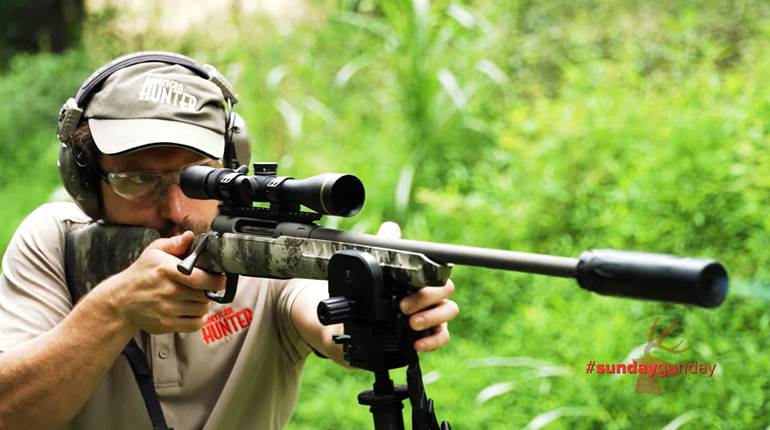
SilencerCo recently introduced a modular suppressor, the Omega 36M. Built around a two-piece modular design, the Omega 36M can be used in full-length and shorter-length configurations, and can handle up to .338 Lapua for rifles and 9 mm for handguns.
The most impressive thing about the Omega 36M? Even in the short configuration, most of the firearms I tested with the Omega 36M still had the blast brought down below the 140 decibel (dB) level, which the federal Occupational Safety and Health Administration (OSHA) considers the threshold for noises that will damage hearing.
I have used other modular suppressors that are easily split into long and short versions. Yet, as I discovered in most cases, the short versions simply did not reduce the noise to hearing safe levels, making me wonder why they even existed.
In July 2019 I was at the SilencerCo media introduction of the Omega 36M, held in and around the SilencerCo facility in West Valley City, Utah. I spent two days testing the suppressor on a variety of firearms, using a decibel meter to gauge noise levels.
The Omega 36M sports a fully welded rear core and a fully welded front module. No cheap stampings here. The core of the Omega 36M is constructed of two high-tech alloys: the very strong and light Cobalt 6; and the extremely heat-resistant Inconel. The titanium outer tube combined with the lock-ring prevents the tube from loosening and reduces weight, and the unit is finished with a black Cerakote for added durability. 
The 36M has an outside diameter of 1.57” and weighs in at 13.7 ozs. in the short configuration with the ASR mount, and 16.5 ozs. in the long version also with the ASR mount. In the long configuration and with no mounting hardware, the Omega 36M is just a shade under 7” long; the shorter version’s length is reduced by almost two full inches.
This suppressor ships with SilencerCo’s Charlie ASR mount, and the suppressor itself is compatible with all other SilencerCo Charlie style mounting systems. The updated Charlie front cap allows for tool-less removal and the rear Charlie mounting system provides better mount to suppressor retention than past mounts.
The Omega 36M can also be attached right to a rifle barrel using SilencerCo’s Charlie Direct Thread Mounts and can be threaded on a pistol by using the company’s Charlie Pistol Housing and any of the SilencerCo Piston mounts. The SilencerCo mounts are offered in an extensive number of thread pitches to cover most common rifles and pistols.
The Omega 36M is expected to be available by early December 2019, at an MSRP of $1,187.

On Day One, I used the Omega 36M at an outside range, in the long and short configurations, on rifles and semi-automatic pistols. Rifles included the Marlin 336 Dark Series lever action chambered in .30-30 Win., and the Ruger American in the new .350 Legend cartridge. Both rifles had Omega 36M’s in the long configuration attached. I shot the rifles without hearing protection and they were very easy on my ears.
Recoil, by the way, was also minimal in both rifles, noticeably less than the un-suppressed version I’ve used in both calibers.
For pistols, I shot an Ed Brown 1911 in 9 mm with a long-configuration Omega 36M and a Glock 34 in 9 mm with a short-configuration Omega 36M. Both pistols were a pleasure to shoot thanks to minimal noise; the weight of the suppressor and its ability to minimize recoil greatly reduced muzzle rise on both handguns, too.
The author fires a Glock 34 with the Omega 36M in the long configuration, outside.
Outside, a suppressed firearm is almost always relatively quiet, the blast quickly dissipating in the open air. But that doesn’t measure decibel levels.
So, for me, the real testing came the morning of Day Two at the SilencerCo facility, down in the basement shooting range where most of the company’s research and development testing occurs. The key pieces of gear that day were the Lab View decibel meter with G.R.A.S. microphones.
To test the Omega 36M, SilencerCo R&D Technician Josh Graham, below (who, because of his speed, did most of the firing), and I fired the following firearms, using the new suppressor in both the long- and short-configurations: a Glock 34 in 9 mm; an H&K MP5 in 9 mm; a Ruger American bolt-action rifle chambered in .350 Legend; a Remington MSR rifle in 6.5 Creedmoor; a Remington 700 chambered in .308 Win.; a Tikka T3 in .300 Win Mag; and a .338 Lapua Barrett MRAD rifle.
SilencerCo's Josh Graham firing the Remington PSR in 6.5 Creedmoor during sound level testing at the company’s R&D lab.

Josh Graham (left) and Josh Sensinger, of SilencerCo’s R&D team, measure the distance from a rifle’s breech face to the right ear for correct microphone placement during sound level testing.
Josh Sensinger, SilencerCo’s R&D manager, worked the testing equipment and the computer.
At my request, we fired five rounds through each firearm with an Omega 36M in both the long- and short-configurations. Microphones measured the decibel levels at both the firearms’ muzzle and next to the shooter’s right ear.
In the long configuration, all the rifles scored decibel levels below 140 dB at the shooter’s right ear. Notably, the Ruger American in .350 legend with the long-configuration Omega 36M averaged an impressive 130.6 dBs at the right ear, using Winchester Power Point 180-gr. loads. With the shorter version attached, the rifle still averaged 133.8 dBs at the ear.
The Tikka T3 in .300 Win Mag scored a right-ear average of 132.7 dBs, with Federal Gold Medal Match 190-gr. ammunition, and 138.7 dB’s average in the short configuration. Using Barnes Precision Match 300-gr. rounds, the Barrett MRAD in .338 Lapua had an average sound level of 134.6 dBs at the right ear, while the short-configuration Omega just missed the OSHA threshold by averaging 141.7 dBs.
I think this is still a fairly impressive achievement, getting the mighty .338 Lapua close to safe hearing levels with just five inches of suppressor.
For the handgun calibers, the Glock 34 scored 131.3 dBs at the muzzle but 143 dBs at the right ear in the long configuration. Why the difference?
A suppressed semi-automatic pistol is usually louder at the ear than the muzzle, even though the muzzle is further away from the ear, because the decibel recorder’s mics will pick up the noise from the bolt coming back and any blowback exiting with the brass.
The Glock 34 with the Omega 36M in the short configuration averaged 135.0 dBs at the muzzle and 144.5 dBs at the right ear.
The author tests a Ruger American chambered in .350 Legend with the Omega 36M in short configuration during sound testing.
For the H&K MP5, the longer Omega suppressor averaged 124.0 dBs at the muzzle and 135.3 dBs at the right ear. The shorty Omega scored 138 dBs at the muzzle and 135.7 dBs at the ear.
All in all, the Omega 36M is an extremely functional suppressor, easily switched between rifles and handguns, and can even reduce a firearm’s report to safe hearing levels in the shorter configuration, in most cases. That shortened suppressor, too, can be very handy in tight situations like hunting blinds or carrying a rifle through thick, brushy areas.
The only problem I see with the Omega 36M? The same problem every suppressor in this country faces--the federal bureaucratic red tape making it more difficult, more costly and more time consuming for us to acquire this extremely useful form of hearing protection! With hope, that will one day change.





































